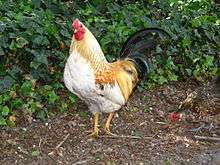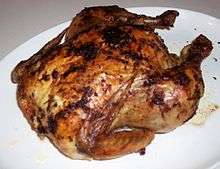Cookbook:Chicken
Cookbook | Recipes | Ingredients
| Basic foodstuffs | Meat and poultry

The chicken is a descendant of the southeast Asian red jungle fowl first domesticated in India around 2000 B.C. Most of the birds raised for meat in America today are from the Cornish (a British breed) and the White Rock (a breed developed in New England). Broiler-fryers, roasters, stewing/baking hens, capons and Rock Cornish hens are all chickens. The following are definitions for these:
- Broiler-fryer - a young, tender chicken about 7 weeks old which weighs 2 1/2 to 4 1/2 pounds (1 to 2 kg) when eviscerated. Cook by any method.
- Rock Cornish Game Hen- a small broiler-fryer weighing between 1 and 2 pounds (0.5 to 1 kg). Usually stuffed and roasted whole.
- Roaster - an older chicken about 3 to 5 months old which weighs 5 to 7 pounds (2.25 to 3.25 kg). It yields more meat per pound than a broiler-fryer. Usually roasted whole.

- Capon - Male chickens about 16 weeks to 8 months old which are surgically unsexed. They weigh about 4 to 7 pounds (1.75 to 3.25 kg) and have generous quantities of tender, light meat. Usually roasted.
- Stewing/Baking Hen - a mature laying hen 10 months to 1 1/2 years old. Since the meat is less tender than young chickens, it's best used in moist cooking such as stewing.
- Cock or rooster - a mature male chicken with coarse skin and tough, dark meat. Requires long, moist cooking.
Chicken eggs are also used for food. See that module for more information.
Food Borne Organisms Associated with Chicken
As on any perishable meat, fish or poultry, bacteria can be found on raw or undercooked chicken. They multiply rapidly at temperatures between 4 °C (40 °F) and 60 °C (140 °F) (out of refrigeration and before thorough cooking occurs). Freezing doesn't kill bacteria but they are destroyed by thorough cooking of any food to 71 °C (160 °F).
Most food borne illness outbreaks are a result of contamination from food handlers. Sanitary food handling and proper cooking and refrigeration should prevent food borne illnesses.
Bacteria must be consumed on food to cause illness. They cannot enter the body through a skin cut. However, raw poultry must be handled carefully to prevent cross-contamination. This can occur if raw poultry or its juices contact cooked food or foods that will be eaten raw such as salad. An example of this is chopping tomatoes on an unwashed cutting board just after cutting raw chicken on it.
Following are some bacteria associated with chicken:
- Salmonella Enteriditis may be found in the intestinal tracts of livestock, poultry, dogs, cats and other warm-blooded animals. This strain is only one of about 2,000 kinds of Salmonella bacteria; it is often associated with poultry and shell eggs.
- Staphylococcus aureus can be carried on human hands, in nasal passages, or in throats. The bacteria are found in foods made by hand and improperly refrigerated, such as chicken salad.
- Campylobacter jejuni is one of the most common causes of diarrheal illness in humans. Preventing cross-contamination and using proper cooking methods reduces infection by this bacterium.
- Listeria monocytogenes was recognized as causing human food borne illness in 1981. It is destroyed by cooking, but a cooked product can be contaminated by poor personal hygiene. Observe "keep refrigerated" and "use-by" dates on labels.
How to Handle Chicken Safely
Fresh Chicken
Chicken is kept cold during distribution to retail stores to prevent the growth of bacteria and to increase its shelf life. Chicken should feel cold to the touch when purchased. Select fresh chicken just before checking out at the register. Put packages of chicken in disposable plastic bags (if available) to contain any leakage which could cross-contaminate cooked foods or produce. Make the grocery your last stop before going home.
At home, immediately place chicken in a refrigerator that maintains 40 °F (4 °C), and use within 1 or 2 days, or freeze at 0 °F (-18 °C). If kept frozen continuously, it will be safe indefinitely.
Chicken may be frozen in its original packaging or repackaged. If freezing longer than two months, overwrap the porous store plastic packages with airtight heavy-duty foil, plastic wrap or freezer paper, or place the package inside a freezer bag. Use these materials or airtight freezer containers to repackage family packs into smaller amounts or freeze the chicken from opened packages.
Proper wrapping prevents "freezer burn," which appears as grayish-brown leathery spots and is caused by air reaching the surface of food. Cut freezer-burned portions away either before or after cooking the chicken. Heavily freezer-burned products may have to be discarded because they might be too dry or tasteless.
Ready-Prepared Chicken
When purchasing fully cooked rotisserie or fast food chicken, be sure it is hot at time of purchase. Use it within two hours or cut it into several pieces and refrigerate in shallow, covered containers. Eat within 3 to 4 days, either cold or reheated to 165 °F (hot and steaming). It is safe to freeze ready-prepared chicken. For best quality, flavor and texture, use within 4 months.
Safe Defrosting
There are three recommended ways to defrost chicken: in the refrigerator, in cold running water and in the microwave. Never defrost chicken on the counter or in other locations. It's best to plan ahead for slow, safe thawing in the refrigerator. Boneless chicken breasts will usually defrost overnight. Bone-in parts and whole chickens may take 1 to 2 days or longer. Once the raw chicken defrosts, it can be kept in the refrigerator an additional day or two before cooking. During this time, if chicken defrosted in the refrigerator is not used, it can safely be refrozen without cooking first.
Chicken may be defrosted in cold water in its airtight packaging or in a leak proof bag. Submerge the bird or cut-up parts in cold water, changing the water every 30 minutes to be sure it stays cold. A whole (3 to 4 pound (1 to 2 kg)) broiler fryer or package of parts should defrost in 2 to 3 hours. A 1-pound (500 g) package of boneless breasts will defrost in an hour or less.
Chicken defrosted in the microwave should be cooked immediately after thawing because some areas of the food may become warm and begin to cook during microwaving. Holding partially cooked food is not recommended because any bacteria present wouldn't have been destroyed. Foods defrosted in the microwave or by the cold water method should be cooked before refreezing.
Do not cook frozen chicken in the microwave or in a slow cooker. However, chicken can be cooked from the frozen state in the oven or on the stove. The cooking time may be about 50% longer. Some advise against cooking frozen meat and poultry altogether; with chicken, always check the temperature with a food thermometer to ensure proper cooking.
Marinating
Chicken may be marinated in the refrigerator up to 2 days. Boil used marinade before brushing on cooked chicken. Discard any uncooked leftover marinade.
Chicken Recipes
These recipes feature chicken as the main ingredient:
- Coq au Vin
- Jamaican Chicken Fingers with Honey-Mustard Sauce
- Jamaican Jerk Chicken
- Midwestern Chicken Wings
- Paprika Chicken
- Peanut Chicken Stir-Fry
- Rosól
- Chicken Fajitas
See also Category:Chicken recipes